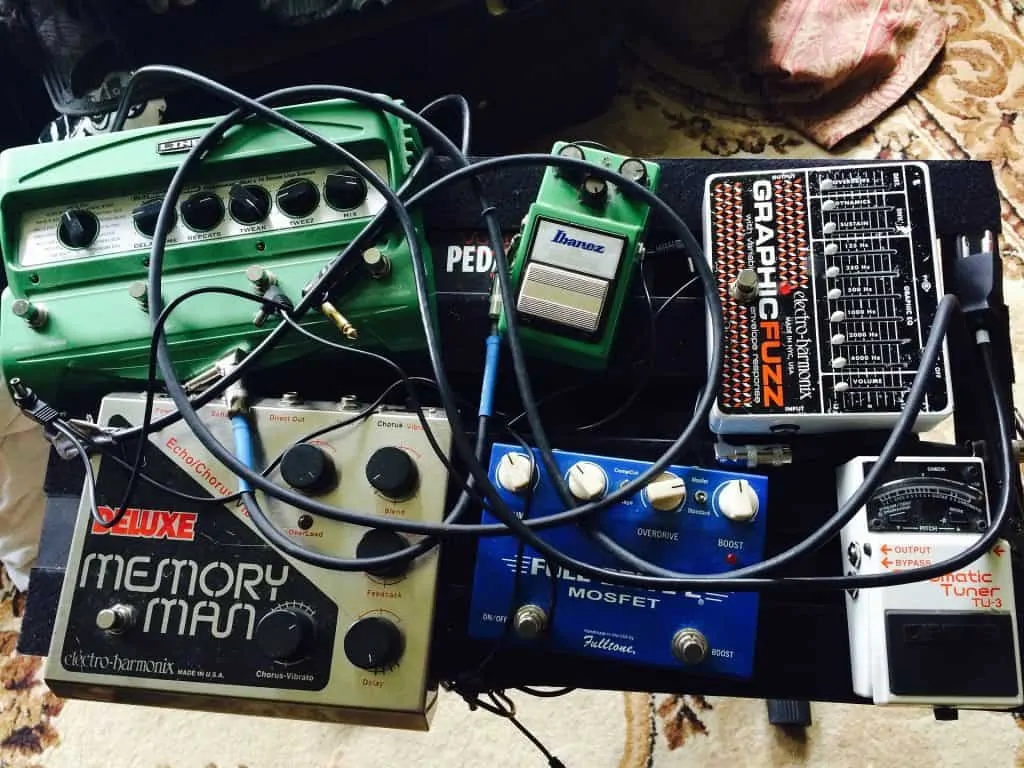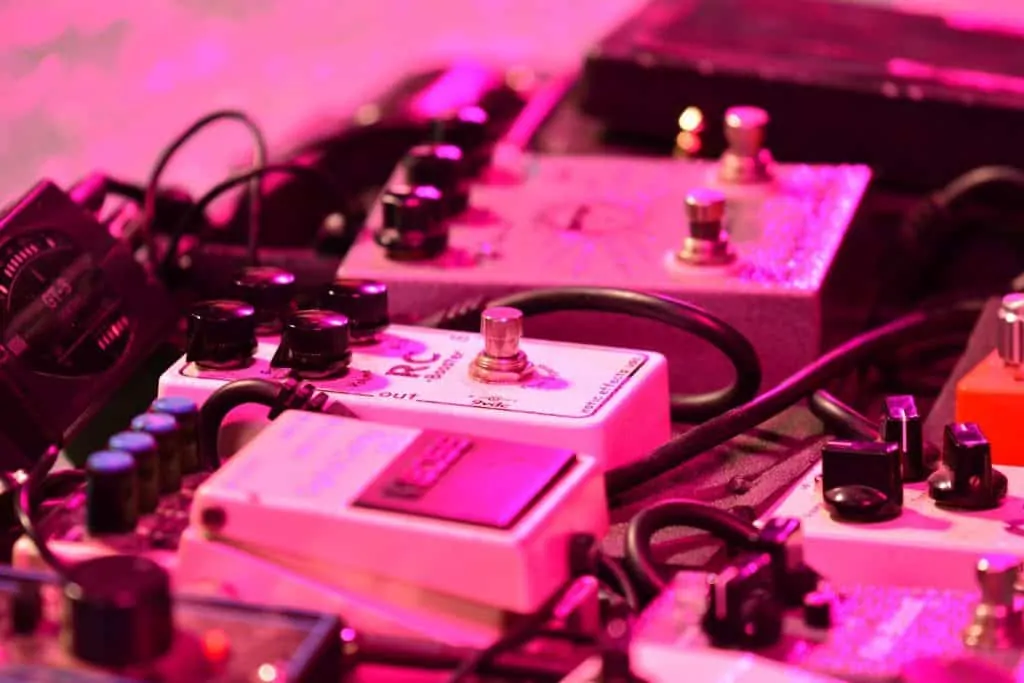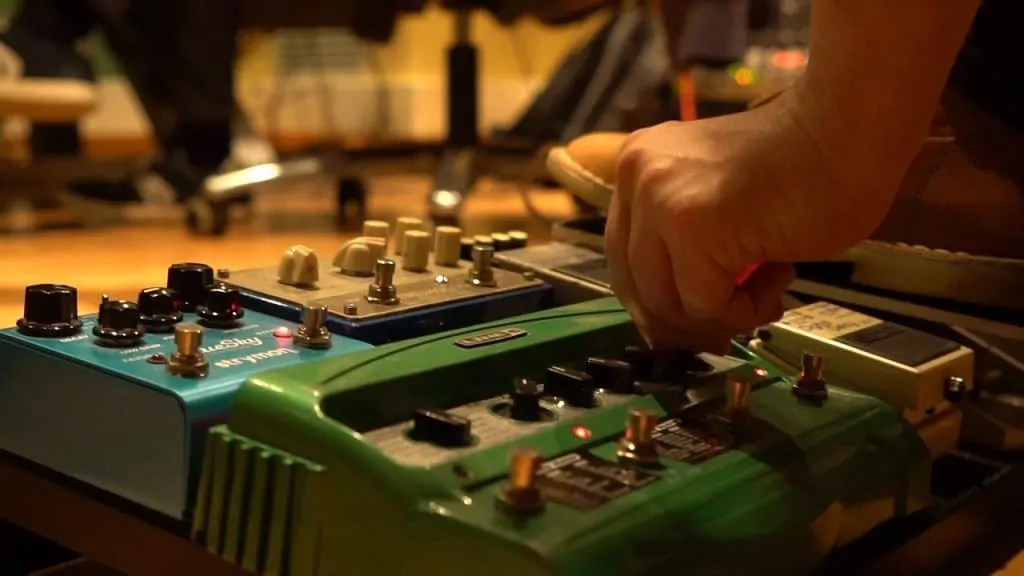At BeginnerGuitarHQ, we like to guide you towards an incredible set-up for your guitar as well as some brilliant playing skills. Once you’ve got the basics down (or even before, if you want) dig deep into this article and figure out which looper pedal is the one for you. Then, you’ll be able to become your own band!
In this important guide, I’ll talk you through ten of the best looper pedals on the market, for various different needs based on style, requirement and instrument preference.
If you’re looking to get yourself a great looper pedal, then look no further.
Contents
First Things First
The first thing to do when hunting for a looper pedal is decide what you need it for. Are you playing in your room? In that case, don’t worry too much about tone. Obviously, you don’t want the pedal to ruin the sound you’ve carefully crafted with your guitar, but at the same time, you don’t have to worry too much about impressing with your tone if you’re just practicing.
Things change a lot while on stage. Take a look at Ed Sheeran, for example. His on stage set-up requires just an acoustic guitar and a lot of pedals. This means his looper has to be the best around, because it not only needs to be able to intuitively follow his tempos, but replicate the exact sound he played into it.
I’d personally not recommend that you record with a looper pedal. This is because you can have a lot more control over your loops if you simply record them in and multi-track (or even edit them inside your VST). However, if you absolutely must, then the situation is basically the same as live performance: you want the signal that comes out of the pedal to match the signal that went in.
There are a few other things you’ll want to look out for. For example, the user interface. There are a few particularly impressive pedals that can lock into a tempo almost follow your playing. You’ll be able to set them up so that it automatically sets the loop where you want it to, meaning you barely have to interfere with the pedal. However, there are many models that require you to click in the loop yourself. Which approach you’d rather is pretty much down to personal preference.
The final thing to mention is that looper pedals often have quite a challenging learning curve. This means you’ll probably be flicking through the instructions for a weeks after your purchase: this is fine. They’re confusing pieces of kit with a lot of specific behind them. Just stick with it and eventually you’ll have something very powerful at your feet and be able to create some incredible looping arrangements.
Boss RC-300 Loop-Station Looper Pedal
As ever, we start with a pedal from the most iconic brand to ever create guitar effects pedals: Boss. However, for now, we’re leaving what you might associate most to the brand to later and looking at a very high end, extremely complex loop station instead. This board is long, complex and gives you a lot of options that might seem overwhelming at first.
The first thing to notice is that you have controls for three separate stereo tracks at the same time. There are actually nine separate footswitches on this board (plus a separate switch that can be used as a master to control everything if you can’t access this whole board at once). As such, you can operate all three stereo tracks with a ‘record’ switch, and stop it with a ‘stop’ switch. This removes all the confusion of having to tap twice to stop or figure out what mode your pedal is currently in. It’s all there in front of your face.
It also has three hours of recording time, as well as storage to save your favourite loops and come back to them. You can set tempo either specifically or tap it out, control the level of each track, the master, and even add effects. There is a volume pedal on the right and an override on the left that allows you to switch everything off or on at will.
If your budget allows you to delve into such a high price range, then this pedal is pretty much perfect.
ammoon AP-09 Mini Loop
Ammoon are known for their simplicity and low price tag, with their entry into the world of loop pedals being no different. This little white pedal is about as aesthetically pleasing as a pedal can be, and about as simple too.
This means that you’ll click down on the footswitch to start the loop and then click down on it again to let it know you’re done. If simplicity is your thing (and you have an impressive grasp of rhythmic consistency) then you’ll be absolutely fine with this pedal. The true bypass means nothing is affecting your signal without activating the pedal, and considering the price-tag, the playback the pedal provides is actually quite good.
It isn’t over overwhelming accuracy to the point where it would be good for recording, and the ability to loop at the correct tempo is probably a little too risky to take into a live setting, but at the price, this is only designed for the bedroom anyway, and for that, it works wonders. You can also record up to ten minutes of your own content and keep layering over your own loops until your heart is content.
LEKATO Guitar Effect Pedal Guitar Loop Station
The first of two directly competing Lekato pedals on this list is one of the most futuristic pedals we’ve ever seen. It looks like it’s been taken straight out of a sci-fi film set a million years in the future, with an almost full-length LED screen telling you what your pedal is currently doing. Somehow, it manages to retain a relatively low price.
Unlike some loop pedals, the signal this pedal outputs is completely uncompressed and lossless, meaning it should sound pretty much exactly the same as it did when you inputted it, which is a very helpful thing to have on your side. It also has the ability to record up to 40 minutes of audio in strings that can last up to ten minutes. This turns the pedal from a looper into what is effectively a mobile piece of accompaniment software, which could be invaluable for practice.
On top of that, the visualisation of timings is incredibly clear and make it obvious to even the newest of loop pedals to users exactly what it is doing at all times, while even throwing in a tuner at the same time to make sure you’ll sound right over your own loop.
LEKATO Electric Guitar Looper Effect Pedal
Strangely, Lekato are challenging themselves in a market they’re already a part of. This looper doesn’t have the same silky smooth, futuristic design as the one above, but it does have the advantage of a lower price tag. Instead of the complex (but cool) design of the above, this pedal gives you a simple LED to tell you when your loop is active.
It does away with the ability to tune and your actual recording time is limited to five minute loops, making this product a little worst off in terms of being a brilliant practice tool. However, by getting rid of the exciting design, it becomes a much more rugged pedal, capable of being thrown into the back of a van or lugged about on a pedal board for live performance.
It might not have the ability to sync to a tempo (unless you’re able to play with wizard-like rhythmic accuracy) but its foot controls are simple and easy to get a hold of, which is brilliant considering the size and very low price.
Boss RC-1 Loop Station
This is the pedal you might be more accustomed to seeing Boss produce. The main draw to this pedal would of course be if you have a selection of other, almost identical looking, Boss pedals to go alongside it. It just about remains in the double figure range, but it is still more expensive than the other ‘simple’ models on this list. That said, its more complex cousin above is still about five times more pricey.
Stereo input and output mean this pedal can hook up to a PA with minimal issue, meaning that if you’re playing a show with a low-budget set-up that sees you positioned between two speakers with nothing but a pedal and an acoustic guitar, then this shouldn’t be much trouble.
As you can expect from Boss, there is very little to report in terms of sound quality, as everything you’ll hear from this output is going to sound exactly the same as it did when it went in. One unique thing this pedal has going for it is a very clear LED display in the top right that lets you know what mode you’re in, which is something not many loopers do and it can often lead to quite a confusing situation that can really mess with your flow.
Donner Deluxe Looper Guitar Effect Pedal Loop Station
This is an interesting one. The reason I’ve included the Donner Deluxe on this list is thanks to its true uniqueness. The pedal itself is pretty uninspiring to look at, but it gets the job done. The signal you get coming out of the other side is a little compressed and some of the top end gets knocked off, leaving you with a lightly dead signal. However, the footswitch is pretty easy to get the hang of and its overdubbing is quite intuitive, making it absolutely fine for practicing to play over a chord sequence or whatever it is you may need to do. You can also control the panning and signal strength in each of the stereo outputs, which is a really handy feature if you want some good spread while using headphones.
The thing that makes this pedal a winner is the FX pedal on the right hand side. Take a look at the top where all of the control knobs are. You can flick a switch that says ‘change’, ‘forward’ and ‘reverse’. Forward will be where you keep it for normal playback, however, flick it to reverse and click the footswitch on the right and you’ll get a really cool reversing effect on whatever you’ve played into the pedal. Similar, selecting ‘change’ will mean you can impact the speed, from slowing it down a lot to speeding it up a lot. The actual change is a little clunky, but this is a really impressive amount of audio editing that these other pedals don’t afford you.
MXR Clone Looper Pedal
We’re really starting to climb the budget ladder here. This MXR Clone Looper pedal (very clever name, like a Clone Trooper from Star Wars) does pretty much what it says on the tin. You have a pedal on one side that allows you to record or begin your loop, and another on the other side that allows you to stop looping or play a saved (or resume a) loop. Very simple, with a volume control slap bang in the middle.
Unlike a few of these pedals, this one doesn’t mess around with complexity, and places an almost unbeatable sound quality at the top of its list of priorities. While you can’t tap in a tempo or have the pedal provide you with a metronome that will explain exactly when the loop is going to start again, you can hear the exact sound you played in come out the other end. In effect, its promise to ‘clone’ your signal is being kept perfectly.
Pigtronix Infinity Looper, Dual Stereo Loop Pedal
They might have the worst name for a company that makes guitar pedals out of any company that makes guitar pedals, but Pigtronix certainly knows how to make a good one. A quick word of warning before I delve too far into the specifics of how this one works: it’s very expensive.
Anyway, it doesn’t have quite the same monstrous size of the first Boss pedal we looked at, but it does have a very similar level of control and customisation. You only have two loops that can run simultaneously here, but that’s fine, thanks to the unlimited overdubs. The third pedal on the left is simply to stop everything and allow your loops to drop out before you bring them back in with one or both of the other pedals. There is a separate volume control for each one, as well as a panning option and a master volume.
In the middle, you’ll also find the hub that helps you to keep in time with everything. This is very important, and unfortunately, one of the main things that the loopers on the cheaper end of the spectrum are missing. These high end pedals will help you count through everything or input your own tempo to make sure each layer you add stays in time, while a high resolution output means you’ll stay sounding exactly as you did before feeding through the pedal.
As such, this is one of the few on this list that I’d recommend for live performers, both thanks to simplicity and an incredible sound output.
Guitar Effector Dual Delay + Reverb + Looper Multi effects Pedal
It’s quite rare for a looper to be found within a multi-effect unit, but here we are. His is the only other pedal on this list to give you the speed and reverse setting options that the Donner provides. Learning to use the looper is a bit of a challenge, but when you get the hang of it it becomes rather easy. It doesn’t have the intuitive and easy-to-understand nature of some of the other high-end pedals on this list, but if you’re looking to buy this pedal, then looping obviously isn’t the only thing on your mind.
The flurry of control knobs at the top look a little overwhelming and complex, but this is simply a reflection of how impressive and detailed this unit truly is. You have control over various reverbs and two separate delays, all of which being able to be switched on with just one simple click on a pedal that is otherwise covered by a true bypass. On top of this, take a look at the screen in the middle.
There are a variety of built in patches that allow you to emulate specific reverb and delay sounds, while the editability means you can create your own patches. This brings this pedal to a whole new level that none of the others offer, one where you can combine your loops with new and impressive sounds that this pedal can concoct itself.
Fengbingl-mu Loop Guitar Effect Pedal
The final pedal on our list brings the budget down a little bit once more, but is still a pedal firmly aimed at those with a little more to spend on looping. The baby blue, plasticy look might make you think that this is something for beginners, but it’s anything but.
With unlimited overdubs and a built-in reverb, you can instantly create a genuinely huge sound for your playing. There is a ‘studio’ mode that allows you to use a natural, small reverb that is weirdly good for a recording situation, ‘church’ mode that gives the feel of a large, open and empty space if you want your sound to reflect from distant walls (without actually reflecting from distant walls) and a ‘plate’ mode that provides a surprisingly accurate emulation of a plate reverb.
Beyond all of these reverb options is a very simple looper. As with many of the smaller less-budget-brutal options, there is no tempo tap, but as long as you have a good grasp over rhythm, then you’ll be able to get yourself started on a nice loop that can be added to and played over very clearly. There are even options to edit the tone (which is just an EQ filter) or decay, giving an even greater control over the specifics of your sound.
In Conclusion…
You’re going to have to look for a looper pedal with a lot of specifics in mind. A lot of pedals do what they say on the tin (a flanger will always flange your signal, for example) but a lot of looper pedals take very different approaches.
There are a few in the higher range that will basically loop your signal exactly as you played it and you won’t have to worry about any detriment to sound, but that’s only really going to be needed if you’re playing live. You can easily dip down in budget if you’re just practicing in your bedroom. At the same time, you’re going to think about ease of use.
If you’re a total beginner, you’ll probably want a pedal with a very simple use interface. Often, this could be to the detriment of your tone. If you’ve had a lot of experience with looper pedals, then you won’t need to worry about this simplicity; you can probably get your loops down without a lot of thought.




